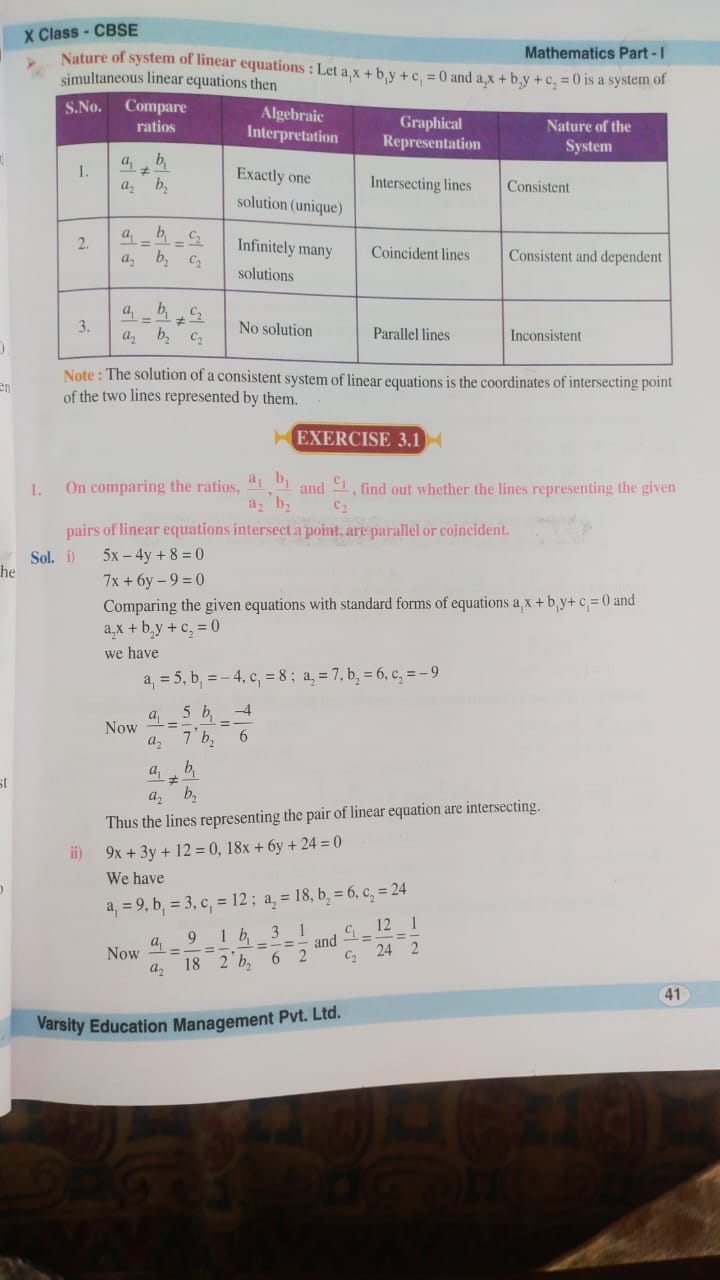QQuestionAccounting
QuestionAccounting
# X Class - CBSE
Nature of system of linear equations : Let $a_{1} x+b_{1} y+c_{1}= 0$ and $a_{2} x+b_{2} y+c_{2}= 0$ is a system of
| S.No. | Compare <br> ratios | Alachvale <br> Interpretation | Graphical <br> Representation | Nature of the <br> System |
| :-- | :-- | :-- | :-- | :-- |
| 1. | $\frac{a_{1}}{a_{2}} \neq \frac{b_{1}}{b_{2}}$ | Exactly one <br> solution (unique) | Intersecting lines | Consistent |
| 2. | $\frac{a_{1}}{a_{2}}=\frac{b_{1}}{b_{2}}=\frac{c_{2}}{c_{2}}$ | Infinitely many <br> solutions | Coincident lines | Consistent and dependent |
| 3. | $\frac{a_{1}}{a_{2}}=\frac{b_{1}}{b_{2}} \neq \frac{c_{2}}{c_{2}}$ | No solution | Parallel lines | Inconsistent |
Note: The solution of a consistent system of linear equations is the coordinates of intersecting point of the two lines represented by them.
## EXERCISE 3.1
1. On comparing the ratios, $\frac{a_{1}}{a_{2}}, \frac{b_{1}}{b_{2}}$ and $\frac{c_{1}}{c_{2}}$, find out whether the lines representing the given pairs of linear equations intersect a point, are parallel or coincident.
Sol. i) $5 x- 4 y+ 8 = 0$
$7 x+ 6 y- 9 = 0$
Comparing the given equations with standard forms of equations $a_{1} x+b_{1} y+c_{1}= 0$ and $a_{2} x+b_{2} y+c_{2}= 0$
we have
a_{1}= 5, b_{1}=- 4, c_{1}= 8 ; a_{2}= 7, b_{2}= 6, c_{2}=- 9
Now $\frac{a_{1}}{a_{2}}=\frac{5}{7}, \frac{b_{1}}{b_{2}}=\frac{- 4}{6}$
\frac{a_{1}}{a_{2}} \neq \frac{b_{1}}{b_{2}}
Thus the lines representing the pair of linear equation are intersecting.
ii) $9 x+ 3 y+ 12 = 0,18 x+ 6 y+ 24 = 0$
We have
$a_{1}= 9, b_{1}= 3, c_{1}= 12 ; a_{2}= 18, b_{2}= 6, c_{2}= 24$
Now $\frac{a_{1}}{a_{2}}=\frac{9}{18}=\frac{1}{2}, \frac{b_{1}}{b_{2}}=\frac{3}{6}=\frac{1}{2}$ and $\frac{c_{1}}{c_{2}}=\frac{12}{24}=\frac{1}{2}$
Attachments

5 months agoReport content
Answer
Full Solution Locked
Sign in to view the complete step-by-step solution and unlock all study resources.
Step 1: Compare the ratios of coefficients for the given pairs of linear equations.
Since $\frac{a_{1}}{a_{2}} \neq \frac{b_{1}}{b_{2}}$, the lines representing these equations will intersect at a single point.
Step 2: Compare the ratios of coefficients for the second pair of equations, $9x + 3y + 12 = 1$ and $18x + 6y + 24 = 1$.
Since $\frac{a_{1}}{a_{2}} = \frac{b_{1}}{b_{2}} = \frac{c_{1}}{c_{2}}$, the lines representing these equations are coincident and have infinitely many solutions.
We have:
Final Answer
1. The lines representing the first pair of equations intersect at a single point. 2. The lines representing the second pair of equations are coincident and have infinitely many solutions.
Need Help with Homework?
Stuck on a difficult problem? We've got you covered:
- Post your question or upload an image
- Get instant step-by-step solutions
- Learn from our AI and community of students